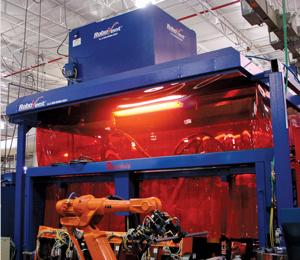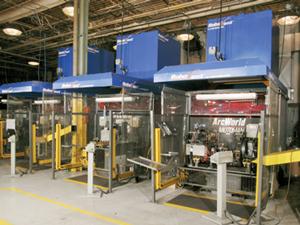- FMA
- The Fabricator
- FABTECH
- Canadian Metalworking
Categories
- Additive Manufacturing
- Aluminum Welding
- Arc Welding
- Assembly and Joining
- Automation and Robotics
- Bending and Forming
- Consumables
- Cutting and Weld Prep
- Electric Vehicles
- En Español
- Finishing
- Hydroforming
- Laser Cutting
- Laser Welding
- Machining
- Manufacturing Software
- Materials Handling
- Metals/Materials
- Oxyfuel Cutting
- Plasma Cutting
- Power Tools
- Punching and Other Holemaking
- Roll Forming
- Safety
- Sawing
- Shearing
- Shop Management
- Testing and Measuring
- Tube and Pipe Fabrication
- Tube and Pipe Production
- Waterjet Cutting
Industry Directory
Webcasts
Podcasts
FAB 40
Advertise
Subscribe
Account Login
Search
Cleaning the air, boosting morale
Automotive stamper integrates welding capabilities, stresses employee health
An aggressive approach to health and safety and an equally uncompromising approach to air filtration at the E&E Manufacturing Plant in Plymouth, Mich., has helped the company earn a safety award from the Occupational Safety and Health Administration (OSHA), garnered appreciation from its employees, and has reduced operating costs for this supplier to the automotive industry.
In November 2003 E&E Manufacturing's Plymouth plant became the first automotive stamping plant in the nation to achieve OSHA's Voluntary Protection Program (VPP) Star Award, which recognizes exemplary safety and health management systems. The Star Award designation is the most rigorous, recognizing the "best of the best" in safety and health, according to Richard Sbroglia, safety and training manager, who is responsible for all safety and compliance issues and health requirements for E&E.
Welding activity at the plant has increased dramatically over the past five years because of customer demand. To meet that demand, the plant now has numerous welding cells, which create a lot of welding smoke and debris inside the plant.
"We have a very aggressive stance on our employees' health," said Sbroglia. "Safety and air filtration for welding fumes are concerns. It was not an option when we began to do welding. We had to do something to contain the fumes and smoke that are part of the welding process. There was really no discussion. It was simply something that had to happen."
Which System to Use?
E&E did a cost comparison of various air filtration systems, comparing unit cost, operation costs, and performance level. E&E decided to use RoboVent™ self-contained air filtration systems from Great Lakes Air Systems, Clawson, Mich., because of the unit's flexibility and portability, according to Sbroglia.
The RoboVent FloorSaver air filtration unit mounts directly on the top of the welding cell, uses no ductwork, and can be moved with the cell (see Figure 1). The unit captures 100 percent of welding smoke and fumes at the source as they are produced, filters and cleans the air, and returns clean air to the plant.
With welding operations at the Plymouth plant growing rapidly, Sbroglia said they selected the system because it does not use ductwork and is easy to move.
"We save thousands of dollars every time we move welding cells because we don't have to reduct and reduct," Sbroglia said.
Sbroglia also noted the plug-and-play portability of the system is a big asset for a growing company that has to reset its plant floor frequently.
"We're able to unplug a robot in about 45 minutes, move it to its new location, reconnect the cell to the power supply, and in about two or three hours we'll be able to run it," Sbroglia explained.

Figure 1E&E wanted a ventilation system that could be moved easily with its welding cells. The RoboVent system shown here mounts directly on top of the welding cell and requires no ductwork.
"If I asked somebody to move ductwork, they'd say it would be two weeks; I'd have to get a quote; get the quote approved; get a layout; go through the move; and pay the bill."
Sbroglia said they also considered that the ventilation system eliminates shutdowns caused by ventilation system failures (see Figure 2).
"If you have a central ventilation system failure, you've affected every welding cell that's attached. With the RoboVent, since they are self-contained on individual cells, if one goes down, the rest of the department is still running and you're just dealing with the one unit that's down."
E&E, which has been using Great Lakes products since 1998, currently has six floor-saver units and one floor-mount unit.
Clean Air, Content Employees
"Good air quality improves employee morale immen sely. Employee morale is positive because they are not concerned about fumes coming off of the machines and making them feel ill, or even giving the perception of feeling ill. So employees are more content at the jobs they're doing."
Sbroglia said that employees and visitors notice the air quality within the plant. He noted that one of the welding technicians recently commented about how clean the air was in the plant compared to where he used to work. During a recent visit from the OSHA industrial hygienist assigned to the plant, Sbroglia said she could not believe the visual air quality in the plant, and when she did OSHA tests, they came back with no issues whatsoever.
Sbroglia believes that operating without adequate air filtration in a welding plant is asking for problems, particularly in elevated workers' comp costs, poor employee morale, and low quality of work.
"There are very few things that we have control over in regards to impact on the bottom line," he said. "Our customers are constantly asking for price givebacks, and our suppliers are constantly trying to elevate the cost of their supplies to us. One of the things we have impact on is the cost of our workers' compensation insurance. By having a very aggressive health and safety program, we can reduce our workers' compensation costs dramatically. A clean, healthy plant also leads to low employee turnover and good employee morale, so it just makes good business sense to have a safe, healthy work environment."
About the Publication
Related Companies
subscribe now

The Welder, formerly known as Practical Welding Today, is a showcase of the real people who make the products we use and work with every day. This magazine has served the welding community in North America well for more than 20 years.
start your free subscription- Stay connected from anywhere

Easily access valuable industry resources now with full access to the digital edition of The Fabricator.

Easily access valuable industry resources now with full access to the digital edition of The Welder.

Easily access valuable industry resources now with full access to the digital edition of The Tube and Pipe Journal.
- Podcasting
- Podcast:
- The Fabricator Podcast
- Published:
- 04/16/2024
- Running Time:
- 63:29
In this episode of The Fabricator Podcast, Caleb Chamberlain, co-founder and CEO of OSH Cut, discusses his company’s...
- Trending Articles
Sheffield Forgemasters makes global leap in welding technology

Welding student from Utah to represent the U.S. at WorldSkills 2024

Lincoln Electric announces executive appointments

Lincoln Electric acquires RedViking

Engine-driven welding machines include integrated air compressors

- Industry Events
16th Annual Safety Conference
- April 30 - May 1, 2024
- Elgin,
Pipe and Tube Conference
- May 21 - 22, 2024
- Omaha, NE
World-Class Roll Forming Workshop
- June 5 - 6, 2024
- Louisville, KY
Advanced Laser Application Workshop
- June 25 - 27, 2024
- Novi, MI




























